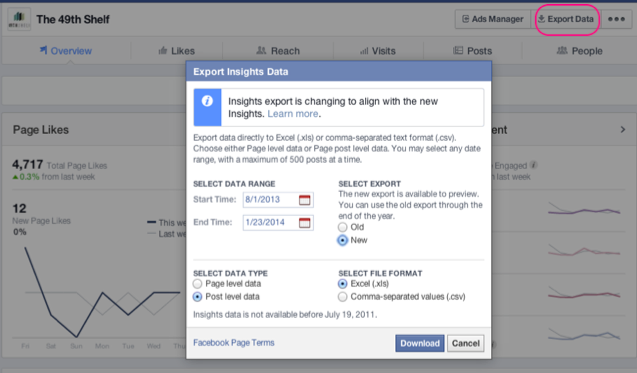 3 Steps to Measuring the Success of Online Marketing Campaigns
3 Steps to Measuring the Success of Online Marketing Campaigns
Presented Sept. 18 as part of BookNet Canada and ABPBC’s Defining Success: Accountable Online Marketing for Book Publishing
If you’re not measuring the results of your marketing efforts, then you are wasting money. Here are 3 steps to planning, measuring and improving online campaigns.
Step 1. Establish measurable indicators (or KPIs, key performance indicators) for every marketing effort.
Make sure they are measurable! For example, saying “we want to increase sales” is not something you can measure. Many factors influence a person’s decision to buy. Sales are an indicator of success but the exact marketing effort that led to a sale is not measurable. Sending out a postcard and driving people to a specific URL is something we can measure. How many people came to this page. Further to that, if the page has an online form, how many people completed the form. These 2 things are specific and measurable.
A specific, measurable goal might be:
* visiting a certain webpage
* signing up for a newsletter
* completing an online form
By using free tools like Google Analytics you can precisely track how many people complete your goal and where they came from.
Step 2: Determine your cost per conversion.
A conversion is any time that someone completes a desired action. It doesn’t have to be a sale. A conversion is the completion of a measurable, specific goal.
Your cost per conversion is the amount of money you spend divided by the number of conversions you achieve.
If your campaign involves mailing out postcards that direct people to a specific URL with an online form, your goal is getting people to fill out the form. The campaign costs $500. You track the number of online form submissions and receive 50 submissions.
Cost per conversion = $500 / 50 submissions
$10 per conversion.
If your campaign involves sending out an email newsletter that directs people to a specific URL with an online form, your goal is still getting people to fill out the form. The campaign costs $200. You track the number of online submissions and receive 16 submissions.
Cost per conversion = $200 / 16 submissions
$12.50 per conversion
Now that you have this information you can make some better judgements about how to spend your marketing dollars. With the cost per conversion, you can see that the postcard generated a better (cheaper) cost per conversion than the email newsletter, even though the total cost of the postcard was more.
Cost per conversion helps you determine the actual cost instead of just looking at price. (It is like the cost per pound when buying meat.)
Step 3: Determine the Value
To determine if your marketing effort is worth the money or a waste, you need to determine the value of your activities.
Is it worth it to spend $12.50 to get one person to fill out an online form? Maybe yes, maybe no. It depends on the context. If the form is an order form for a product costing $100, maybe yes.
The value per conversion is $100. The cost per conversion is $12.50.
With both sets of numbers in hand, you can look at all your marketing efforts and decide where to allocate your resources: people, time and money. Don’t stop just at the online marketing activities, look at the offline marketing activities.
It drives me mad when online is asked to justify a spend but offline is not. In these scenarios, you’re wasting money. You are making decisions based on gut instinct and experience. We have experience doing x, y, z and it makes us feel good. It’s safe.
Safe can also be a waste of money.
When a conversion is not related to a sale, how do you set value?
Create a point system. You’ll assign an arbitrary number, but it works as a comparative measurement. You always want specific, measurable goals.
1 person opening and reading your email newsletter = 5 points
1 person viewing a specific video = 5 points
1 person signing up for a newsletter = 10 points
1 person creating an account on your ecommerce site = 100 points
Looks arbitrary, but it works.
If you run Campaign 1 and have 300 people viewing a specific video:
300 people * 5 points = 1,500 points
If you run Campaign 2 and have 200 people sign up for your email newsletter:
200 people * 10 points = 2,000 points
The $ value of each campaign is unknown, but we can see the relative effectiveness. Instead of saying, “we should do more of Campaign 1, it drove the most people”, we can see that Campaign 2, although it drove fewer actions, these actions are of higher value.
Before spending any money, always consider what your specific, measurable goal is worth. As long as you can measure relative effectiveness, you can evaluate whether you are wisely spending money.
Armed with the cost per conversion and the value per conversion, you can make a lot of sense out of the results data. You can easily determine which marketing activities are most effective.
Having trouble figuring out a point system?
Understand the relative value of your online and offline activities. Start with your gut instincts, set the arbitrary numbers, and, as you collect accurate, specific and measurable results, refine those arbitrary numbers into actual dollar values.
For example, if your gut tells you that in-person networking events generate a value of 10 points, but posters only generate 5 points. Then you have the beginnings of a scale.
Posters = 5 points
In-person networking = 10 points
If you and your marketing and sales team can agree that online networking and social media is equal to in-person marketing, then online networking is 10 points. If your team is skeptical, then you can negotiate. If online networking is of greater value than posters but lesser value than in-person networking, agree to give it 8 points.
From chaos to order.
Posters = 5 points
Online networking = 8 points
In-person networking = 10 points
Here is how I’d pair off some common online and offline marketing activities. You have to determine the value order and points based on your business context, but you can use these pairings to help those who operate on gut instinct, or those with little experience online, begin to create a point system.
Advertising (radio, print, direct mail) • Online advertising (email ads, banner ads, search ads
Articles in print (circulation numbers) • Articles Online (unique visitors to site)
Marketing messages with telephone hold music • Email signatures
In-person networking • Online networking
Posters • Web badges and widgets
Press releases • Electronic press releases
Letters to the Editor • Blog comments, Online reviews
Referral program • Online affiliate program
TV ads • YouTube videos
Word of Mouth (real world) • Word of Mouth (virtual world: blogs, forums, wikis, email forwards)


